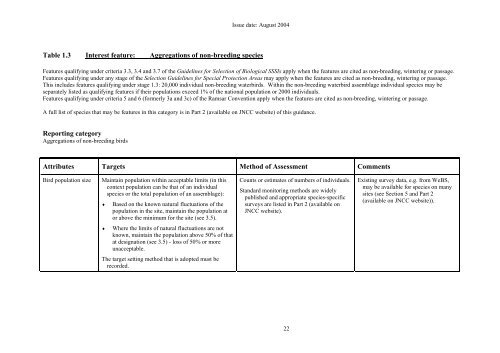Common Standards Monitoring guidance for birds - JNCC
Common Standards Monitoring guidance for birds - JNCC
Common Standards Monitoring guidance for birds - JNCC
You also want an ePaper? Increase the reach of your titles
YUMPU automatically turns print PDFs into web optimized ePapers that Google loves.
Issue date: August 2004<br />
Table 1.3 Interest feature: Aggregations of non-breeding species<br />
Features qualifying under criteria 3.3, 3.4 and 3.7 of the Guidelines <strong>for</strong> Selection of Biological SSSIs apply when the features are cited as non-breeding, wintering or passage.<br />
Features qualifying under any stage of the Selection Guidelines <strong>for</strong> Special Protection Areas may apply when the features are cited as non-breeding, wintering or passage.<br />
This includes features qualifying under stage 1.3: 20,000 individual non-breeding water<strong>birds</strong>. Within the non-breeding waterbird assemblage individual species may be<br />
separately listed as qualifying features if their populations exceed 1% of the national population or 2000 individuals.<br />
Features qualifying under criteria 5 and 6 (<strong>for</strong>merly 3a and 3c) of the Ramsar Convention apply when the features are cited as non-breeding, wintering or passage.<br />
A full list of species that may be features in this category is in Part 2 (available on <strong>JNCC</strong> website) of this <strong>guidance</strong>.<br />
Reporting category<br />
Aggregations of non-breeding <strong>birds</strong><br />
Attributes Targets Method of Assessment Comments<br />
Bird population size<br />
Maintain population within acceptable limits (in this<br />
context population can be that of an individual<br />
species or the total population of an assemblage):<br />
♦<br />
Based on the known natural fluctuations of the<br />
population in the site, maintain the population at<br />
or above the minimum <strong>for</strong> the site (see 3.5).<br />
Counts or estimates of numbers of individuals.<br />
Standard monitoring methods are widely<br />
published and appropriate species-specific<br />
surveys are listed in Part 2 (available on<br />
<strong>JNCC</strong> website).<br />
Existing survey data, e.g. from WeBS,<br />
may be available <strong>for</strong> species on many<br />
sites (see Section 5 and Part 2<br />
(available on <strong>JNCC</strong> website)).<br />
♦ Where the limits of natural fluctuations are not<br />
known, maintain the population above 50% of that<br />
at designation (see 3.5) - loss of 50% or more<br />
unacceptable.<br />
The target setting method that is adopted must be<br />
recorded.<br />
22
















